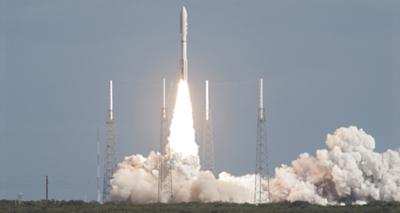Sat, Feb 11, 2012
Data Registers Modified To Correct Reset Problem
Engineers have found the root cause of a computer reset that
occurred two months ago on NASA's Mars Science Laboratory and have
determined how to correct it. The fix involves changing how certain
unused data-holding locations, called registers, are configured in
the memory management of the type of computer chip used on the
spacecraft. Billions of runs on a test computer with the modified
register configuration yielded no repeat of the reset behavior. The
mission team made this software change on the spacecraft's computer
last week and confirmed this week that the update is
successful.
Curiosity Rover Artist's Concept

The reset occurred Nov. 29, 2011, three days after launch,
during use of the craft's star scanner. The cause has been
identified as a previously unknown design idiosyncrasy in the
memory management unit of the Mars Science Laboratory computer
processor. In rare sets of circumstances unique to how this mission
uses the processor, cache access errors could occur, resulting in
instructions not being executed properly. This is what happened on
the spacecraft on Nov. 29.
"Good detective work on understanding why the reset occurred has
yielded a way to prevent it from occurring again," said Mars
Science Laboratory Deputy Project Manager Richard Cook of NASA's
Jet Propulsion Laboratory, Pasadena, CA. "The successful resolution
of this problem was the outcome of productive teamwork by engineers
at the computer manufacturer and JPL."
The Mars-bound spacecraft performed a brief alignment activity
using its star scanner and sun sensor on January 26. During the
alignment observations, the star scanner detected Mars. "Our target
is in view," said JPL's Steve Collins, attitude control subsystem
engineer for Mars Science Laboratory's cruise from Earth to
Mars.
Curiosity Launch

The spacecraft began normal use of its star tracker and true
celestial navigation this week after its software update. The Mars
Science Laboratory mission will use its car-size rover, Curiosity,
to investigate whether the selected region on Mars inside Gale
Crater has offered environmental conditions favorable for
supporting microbial life and favorable for preserving clues about
whether life existed. Curiosity is scheduled to land on Mars on
Aug. 6, 2012, Universal Time and Eastern Daylight Time.
The spacecraft's cruise-stage solar array is producing 704 watts.
The telecommunications rates are 1 kilobit per second for uplink
and 800 bits per second for downlink. The spacecraft is spinning at
1.97 rotations per minute.
As of 1200 EST, (1700 Universal Time) on Friday, February 10, the
spacecraft had traveled 127 million miles of its 352-million-mile
flight to Mars. It will be moving at about 17,800 miles per hour
relative to Earth and at about 63,700 mph relative to the sun.
(Images provided by NASA)
More News
The Industry Continues to be Rocked By Some Questionable Operations Recent investigations and a great deal of data has resulted in ANN’s SportPlane Resource Guide’s rep>[...]
Make Sure You NEVER Miss A New Story From Aero-News Network Do you ever feel like you never see posts from a certain person or page on Facebook or Instagram? Here’s how you c>[...]
Visual Approach Slope Indicator (VASI) An airport lighting facility providing vertical visual approach slope guidance to aircraft during approach to landing by radiating a directio>[...]
Airport Marking Aids Markings used on runway and taxiway surfaces to identify a specific runway, a runway threshold, a centerline, a hold line, etc. A runway should be marked in ac>[...]
Aero Linx: The Skyhawk Association The Skyhawk Association is a non-profit organization founded by former Skyhawk Pilots which is open to anyone with an affinity for the A-4 Skyhaw>[...]
 Unfortunate... ANN/SportPlane Resource Guide Adds To Cautionary Advisories
Unfortunate... ANN/SportPlane Resource Guide Adds To Cautionary Advisories ANN FAQ: Turn On Post Notifications
ANN FAQ: Turn On Post Notifications ANN's Daily Aero-Term (04.29.24): Visual Approach Slope Indicator (VASI)
ANN's Daily Aero-Term (04.29.24): Visual Approach Slope Indicator (VASI) ANN's Daily Aero-Term (04.28.24): Airport Marking Aids
ANN's Daily Aero-Term (04.28.24): Airport Marking Aids ANN's Daily Aero-Linx (04.28.24)
ANN's Daily Aero-Linx (04.28.24)




